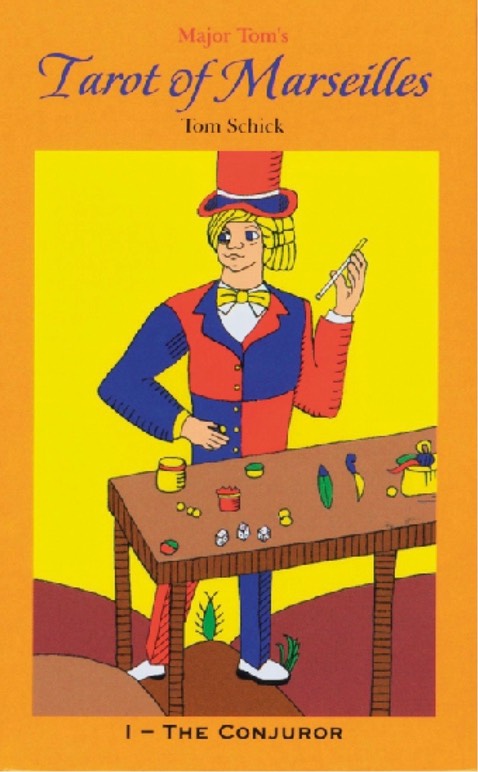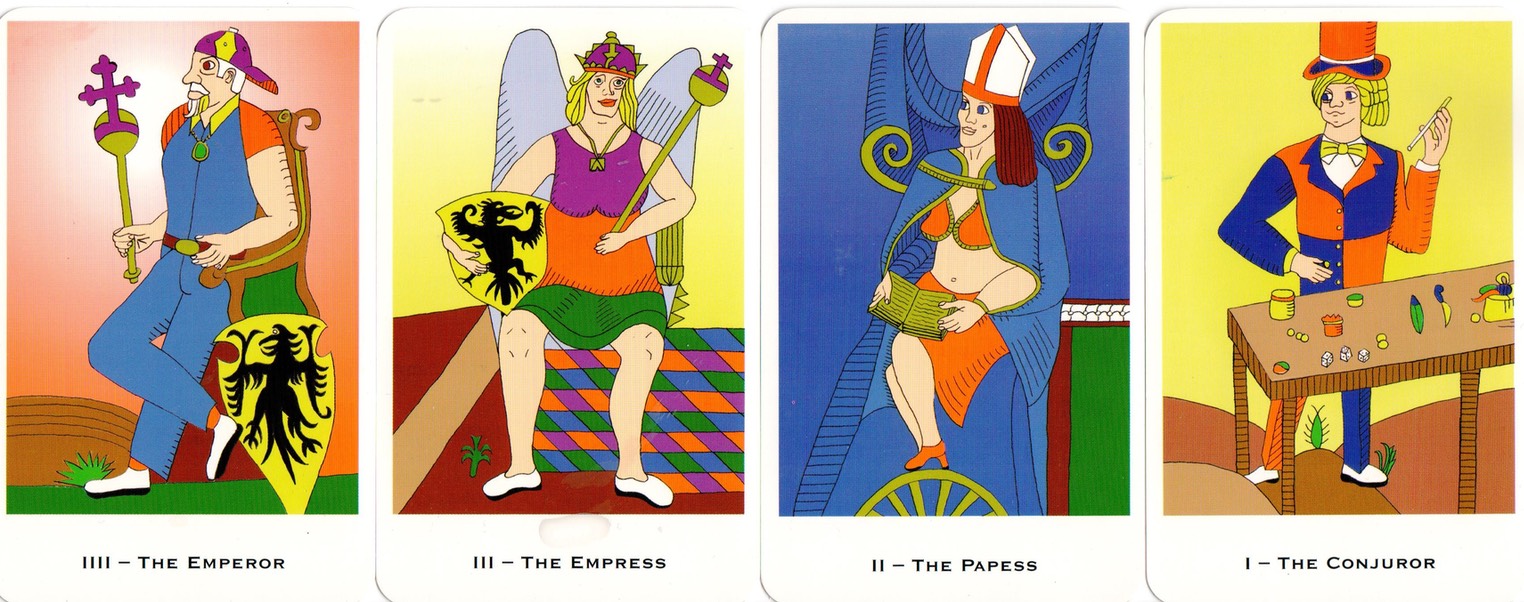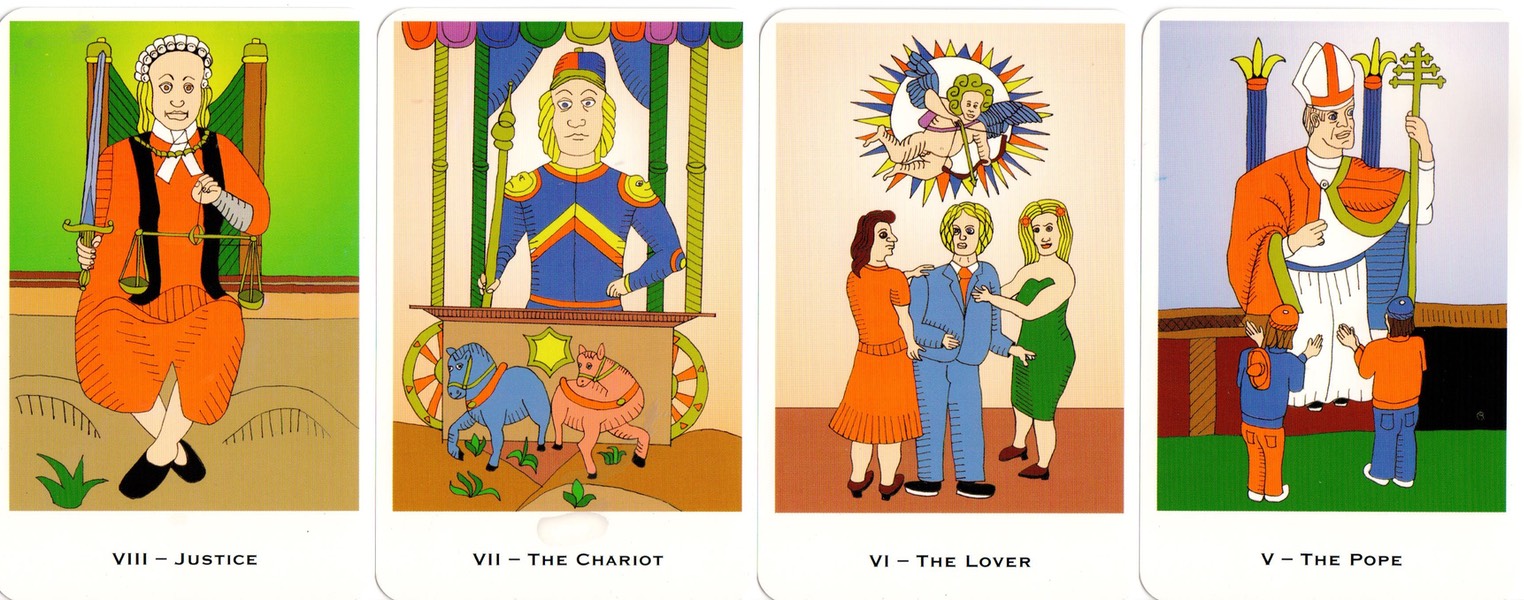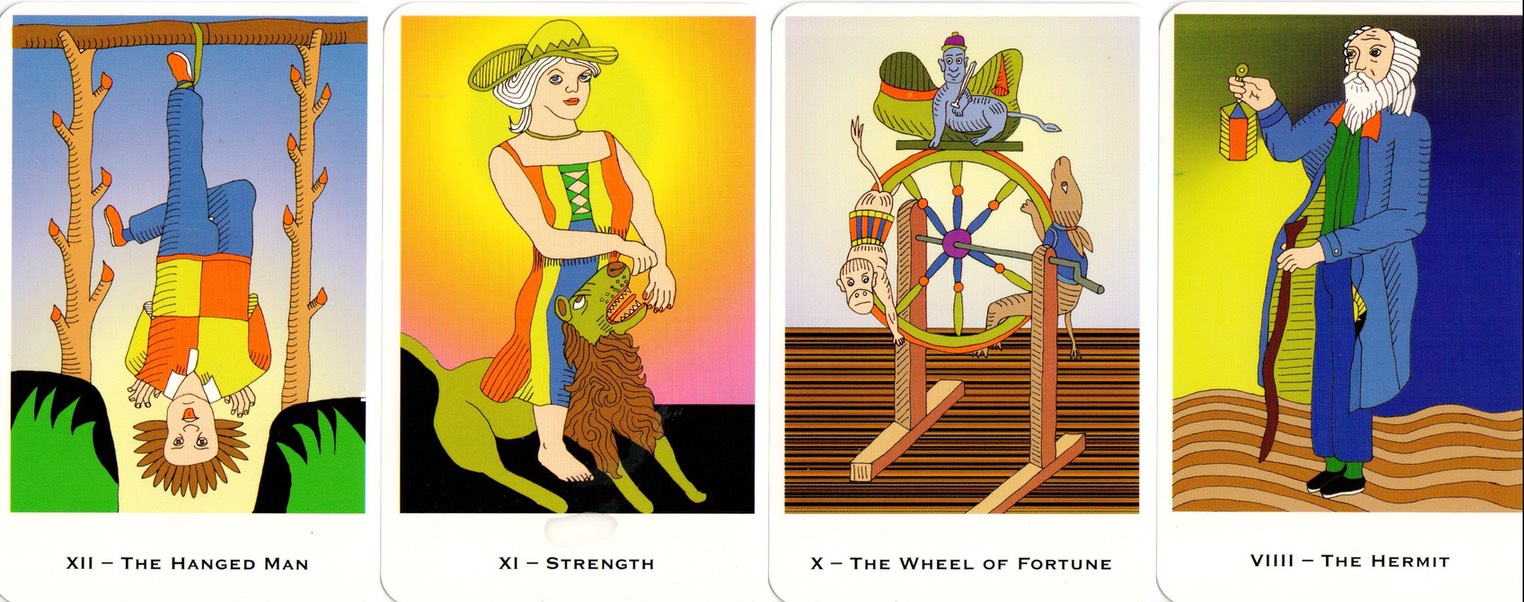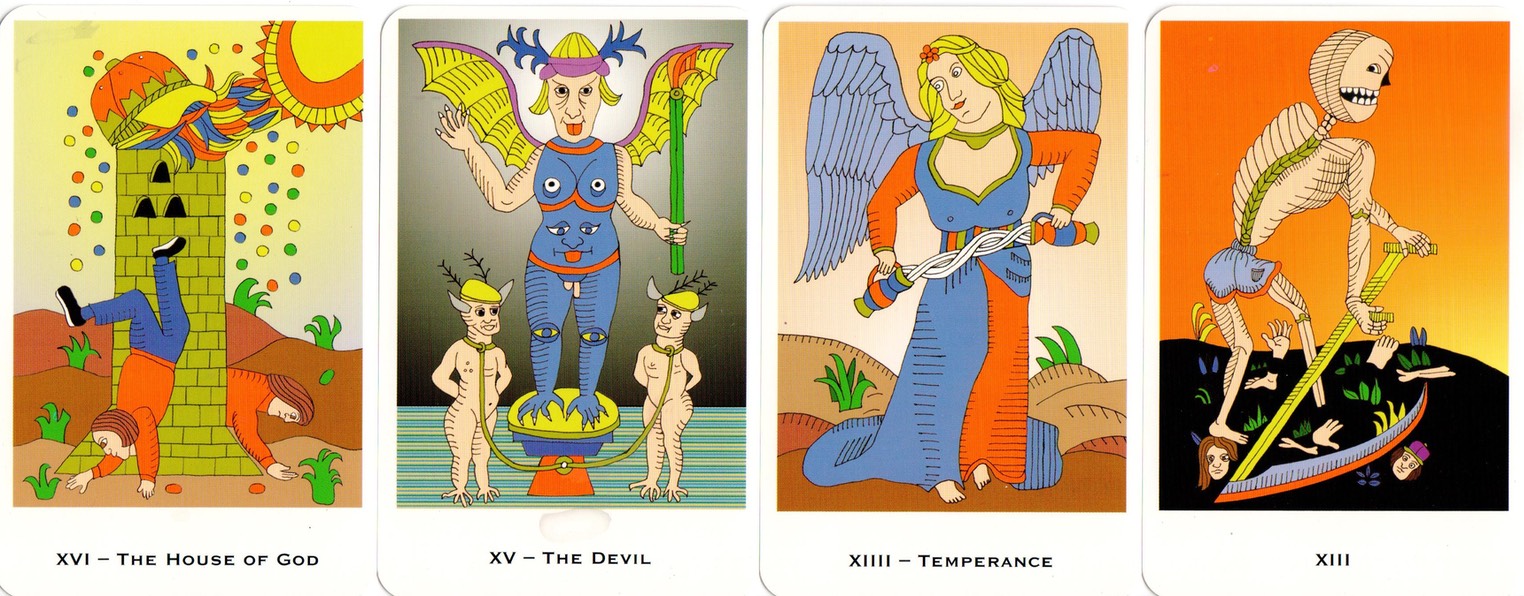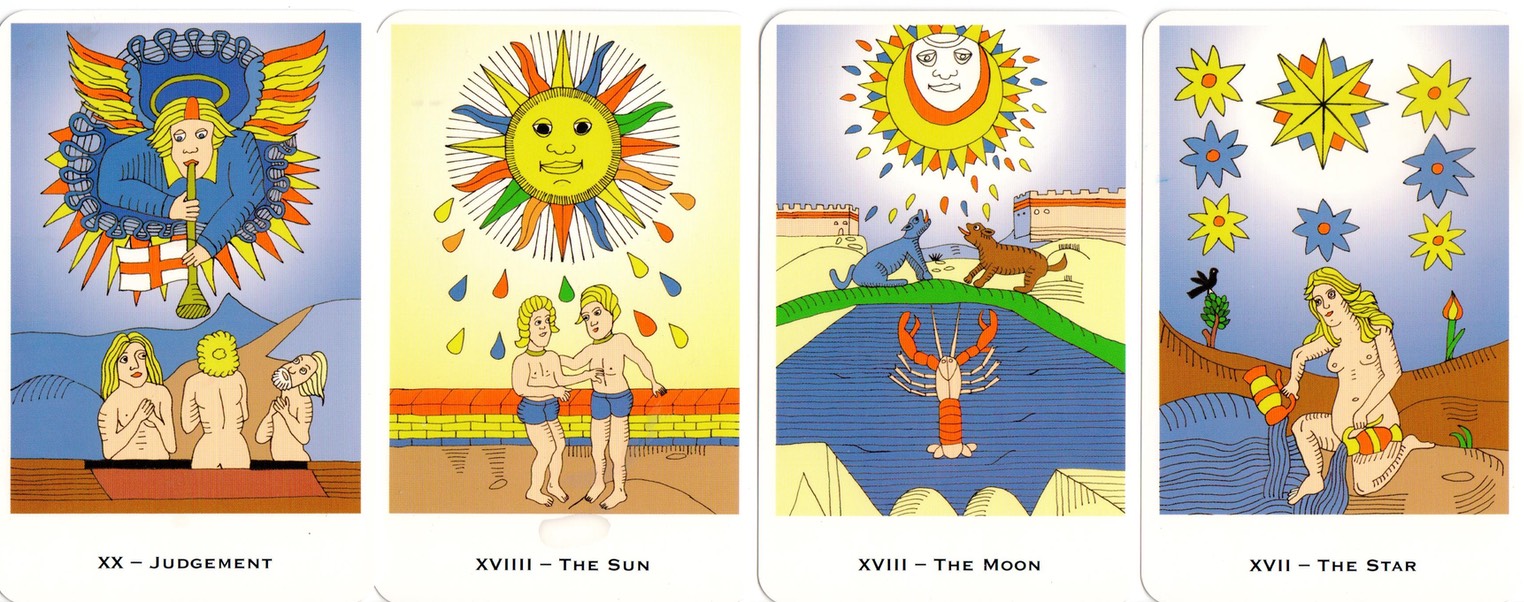An Interview by Francis Ian
Deck Published by Schiffer Books, 2007
http://majortom.biz/decks.html
Introduction
Major Tom Schick, creator of Major Tom's Tarot of Marseilles, Major Tom's La Loteria Oracle deck, and former editor/publisher of the Tarot Lovers' Calendars, was a name I’d seen many times as I studied, collected and read tarot over the last fifteen years. Like Tom, I’d been called to the cards at a young age but I didn’t really begin to walk the path until around 2005, which is also when The Association for Tarot Studies printed a limited edition Major Tom’s Tarot of Marseilles to commemorate the Melbourne International Tarot Conference. My exposure to Major Tom’s Tarot of Marseilles came when Schiffer Publishing released the second edition in 2007. By the time I finally bought the deck, I thought I knew a little something about its creator. It’s always hard to explain how a deck calls to you and connects with you on a personal level. One of the reasons I started writing reviews and conducting interviews was to improve my ability to pull that explanation out. Of all the decks I’ve owned over the years, Major Tom’s is one that gets lots of use, and seems to resonate with querents who comment on the colors, the life within the subjects of the Trumps and the overall aesthetic of the deck. After so many years with his name in front of me, I suspect I know less than I should about Tom. So, let’s get to know this Dallas, Texas tarot master, fortune teller, root doctor and divination teacher, Major Tom Schick and his Tarot of Marseilles.
For a more detailed biography visit: http://www.majortom.biz/about.html
Major Tom’s Tarot of Marseilles Q&A
Ian Bryant: Tom (or should I call you Major Tom), thank you for taking the time to share some thoughts on your tarot deck, Major Tom’s Tarot of Marseilles. If we could, I wanted to focus on the Trumps in this interview and then possibly meet up again to discuss the Pips and Court cards? For me, having read only the Trumps for many years before moving on to esoteric decks where all 78 cards were essential to developing a deep reading, your Trumps all have so much to say and I have so many questions to ask about them! First, I’d love to invite you to greet our American Tarot Association readers and say a few words before we dive into the questions.
Tom Schick: Thank you Ian. Do call me Tom. My friends call me Tom. Your plan sounds fine. I’d also like to take this opportunity to thank the American Tarot Association readers for their interest in my work and this chance to talk about my deck. I find it interesting that you read only the Trumps for many years because I did the same. I didn’t start using the Pips and Courts until I joined and became a moderator on the Aeclectic Tarot Forums.
Major Tom’s Tarot of Marseilles is very much a product of my involvement with the Aeclectic Tarot Forums. Jean-Michel David, organizer of the Melbourne International Tarot Conference and also a moderator on Aeclectic, instigated a 78 week study of tarot cards beginning on the December solstice in 2003 - the 78 weeks leading up to the conference. Participants were to choose a deck to study, one card per week, and post their reflections in weekly threads on the forum. As I planned to present at the conference, I enthusiastically joined the study, choosing the Tarot of Marseilles. I decided to create my own version as part of my study and that became Major Tom’s Tarot of Marseilles. So the deck was created at a rate of one card per week in a very public manner. Although the Aeclectic Tarot Forums are no longer active, the thread is still archived there: http://www.tarotforum.net/showthread.php?t=21916
I was as surprised as anyone when Jean-Michel had a limited edition of the deck printed during the conference and surprised again when Schiffer Publishing approached me to publish a 2nd edition. Major Tom’s Tarot of Marseilles was Schiffer’s first tarot title. I have it in my head to self publish a reprint of the 1st limited edition.
Ian: I’d love to see that reprint come to life! I’m really glad the forum archives are still available so we can get a peek at how it all began. I have Jean-Michelle David’s book Reading the Marseille Tarot (based on his tarot courses) and I believe it is the first one that really made sense to me in reading Marseille decks. I’m glad to hear that there is a connection between J-M David and your deck. I plan on digging into that thread and J-M’s book again, with your deck in hand! Tom, let’s jump into it then...
Francis: I - The Conjuror - Inevitably there is a card that deck creators end up in, whether intentionally or subconsciously. Sometimes it's obvious and sometimes it is a well-kept secret. I think for me I see you in The Conjuror. Is that close or do you see yourself in another card entirely? And how was Will a factor in completing your first version of Major Tom’s Tarot of Marseilles? This card is an expression of active creation and I imagine there was some of that while first drawing your tarot.
Tom: Interesting you see me in this card Ian. I had made an earlier photographic deck that I never finished - it was too small for print. In that deck I was the Magician. I had no conscious thought of putting myself in Major Tom’s Tarot of Marseilles, so you’re probably right. Lately, I’ve had students telling me I look like the Hermit.
For this deck my primary concern was to keep all the Tarot of Marseilles symbolism (including postures) while dressing the characters in modern clothing. It was my thought that dressing the characters in modern clothing would make them more relatable. My very first Tarot of Marseilles was produced by US Games and was a restoration of the Dodal in 4 colors - very stark. I later got a copy of the Dusserre photo-reproduction which remains my favorite. If you look at the Dodal Bateleur and compare it to my Conjuror, you’ll find the faces nearly identical. I redrew the Conjuror for the 2nd edition and you’ll find I was influenced by the Noblet as well.
When first drawing this deck and this was the first card, I looked at every version I could find on-line - which was probably about 12 different Bateleurs. I very much wanted to make sure I had all the details anyone would expect to find in a Tarot of Marseilles.
Francis: II - The Papess - I’m very focused these last few years on the Sacred Feminine and celebrate the women in my life who’ve helped me get where I am today. I’m curious how women and/or the divine feminine has influenced you and your tarot journey?
Tom: Fortune telling in general and tarot in particular are dominated by women. I first discovered tarot cards in my grandmother’s house. My mother introduced me to Paul Foster Case and the B.O.T.A. My romantic partners through the years have encouraged my studies. I wouldn’t be involved in tarot, fortune telling, or root work if it weren’t for the women in my life. I’m grateful for all of them because through them I’ve come to know the divine feminine..
Francis: III - The Empress - Carrying from The Papess, how do you see tarot as a guiding and nurturing mother in a querent’s or reader’s own life? Do you think tarot is a feminine power or more a Yin and Yang of the genders combined? Strangely I often feel a dominant femininity in my own decks, but I suspect that is due to being drawn to decks with that aura.
Tom: I see tarot as more a Yin and Yang of genders combined - at least the more traditional tarot decks. Certainly in some modern tarot decks we can find a dominant gender and that will generally be feminine although I know of some masculine decks too. I like to think Major Tom’s Tarot of Marseilles has a gender balanced energy. Sometimes it can be nurturing like a mother and other times more blunt like a favorite uncle.
Francis: IIII - The Emperor - Apparently 2020 (2+0+2+0=4) is the year of the Emperor! Lon Milo DuQuette, the magician and tarot deck creator (Tarot of Ceremonial Magick) recently did New Year draws for us on Facebook. I was excited to see my card was The Emperor. This card has a wide variety of interpretations in decks when it comes to art. Many are overbearing and dark, while others represent a more positive force. I love your Emperor as I am often that guy, relaxed and (more now then in the past) still in control. Where did you come up with the idea for this card?
Tom: The card I got from Lon Milo DuQuette was the Hermit.
The idea for the Emperor came from the Emperor’s crown, which seemed to me to be shaped just like a baseball cap worn backwards. Once I saw that, the rest was easy. This decision led to me using baseball caps instead of crowns throughout the rest of the deck and leaves the Empress as the only character wearing a crown in the whole deck.
Photo Credit Francis Ian : Deck Major Tom’s Tarot of the Marseilles published by Schiffer Publishing
Francis: V - The Pope - Folks I read for and friends are often surprised to learn I’m Catholic (more “folk” Catholic in practice). The evolution of this card is interesting, and I’m especially drawn to Crowley’s Hierophant card (painted by Lady Frieda Harris) as a practicing magician. On the one hand, the Pope card feels almost more like a figurehead where the Hierophant (interpreter of sacred mysteries and arcane principles) appears to be the true Magician. How do you view the Marseilles Pope in your readings - from a dogmatic religious perspective, or more tied to the mystery of God and our relationship with that mystery?
Tom: I’m Catholic too, although not Roman Catholic, rather Independent Catholic. My parents were heavily involved in the Independent Catholic church - Dad was a Bishop and Mom was a Priest. Independent Catholics call themselves Catholics who believe in spirit and so work with divination and magic.
I tend to see the Pope being about faith and belief - and certainly faith and belief lead to magic. For me, the proper function of the Pope or Hierophant is to serve as a bridge between the physical and spiritual worlds and I can’t think of a better metaphor for magic. It’s also my soul card or birth card and I’ve come to understand the necessity of dedication to a higher power.
Francis: VI - The Lover - Like the Pope, I’ve seen many interpretations of this card over the years. It’s one of the most often “adjusted” meanings and the art can range from erotic to scandelous. I truly appreciate the relationship here of man as moving from mother to wife. I also felt some personal investment in this card. What was your inspiration in creating the card and in developing the text for the booklet?
Tom: My overriding inspiration for the entire deck was to produce a Tarot of Marseilles changing only the clothes the characters wear - not always an easy task and many were highly critical of my choices. For the Lover, I imagined what the characters would wear after the bride and groom had changed to depart on their honeymoon. For me, this card is almost always about choice and the most important choice any of us make is to love.
Francis: VII - The Chariot - This card always makes me think of Jewish chariot mysticism (Merkabah) and I often feel that connection when doing my own readings. In some ways I see the experience of figures like those in the Hebrew Scriptures who ascended in a “chariot” as being driven by the great weight of decision - between the terrestrial and heavenly journeys. Your decision to clothe the Charioteer in a race car driver’s suit is interesting, hinting at the danger of the ride. Is the Chariot a dangerous card to appear in a reading, do you think?
Tom: I always think of Merkabah with this card too. I also think about Plato’s allegory of the soul - a chariot drawn by two horses, one the most noble beast ever seen and the other a broken down nag and controlled without the use of reins. I hadn’t really considered the weight of decision between terrestrial and heavenly journeys so thanks for that. I tend to see this card more in light of Plato’s allegory so weighing up what needs to be done with what one can live with after - the weight of conscience. I think the Chariot can be a dangerous card - it can often appear as a car and thousands die in traffic accidents every year.
Francis: VIII - Justice - I was looking at La Justice from my Papus tarot (reproduced from the cards illustrated in Tarot of the Bohemians) and I reflected on the word “Equilibre” and the sign of Cancer on the card. Not everyone sees life as just, fair or balanced, of course. The question is generally, “Where is Justice?” Does your Justice represent the ideal or the reality?
Tom: I had to look up the Papus tarot because I don’t own one and I have to admit surprise at the sign of Cancer on the card - a sign I most often associate with the Chariot. Since Justice in the Tarot of Marseilles wears a noose around her neck, holds her sword at an angle rather than upright, and over balances the scales with her elbow, I have to say my Justice card represents the earthly reality.
Francis: VIIII - The Hermit - I’m sad to say that where once I fancied myself a hermit, I now tend to not like seeing The Hermit when I’m being read or meditating on my decks. Perhaps it is because I am more social now and less self-involved. That is a negative reading on what the Hermit represents, of course, but I wonder if you’ve ever seen that side of him yourself? Your Hermit is something I am drawn to positively, though, especially as I near retirement age!
Tom: For too long “I kept myself to myself” so yes, I’m very familiar with the negative side of the Hermit. This is one card where I did change the posture of the character from the typical Tarot of Marseilles image of an old man with a curved back. I chose to make him stand upright. With the Hermit standing upright, facing the past, holding up a lantern, I see him as a trailblazer, a leader, reaching new heights first then turning to light the way for others.
Francis: X - The Wheel of Fortune - Of all the Wheel of Fortune cards I’ve seen, I have to admit yours always brings me a wry smile! I was recently in Las Vegas and something about that town always causes me to reflect on my own luck, good and bad, over the years. Even looking at more serious decks, you can get that sense of comic irony in the placement of the figures. How has your own fortune over the years made its way into this card, and why is that monkey wearing a skirt!
Tom: Because I was so focused on creating a deck readily identifiable as a Tarot of Marseilles, I feel the only way I made into this deck is through my use of color, clothing choices, and backgrounds, which I deliberately made brighter than the historical decks. I believe this card closely follows the Dodal and so the major difference is the sphinx is wearing a baseball cap instead of a crown. Every version of the Tarot of Marseilles I’ve looked at has the figure on the left of the card wearing a skirt and I saw no reason to change it.
Francis: XI - Strength - In the Papus deck, Le Tarot Divinatoire, La Force has three statements: La Force Divine, La Force Morale, La Force Humaine. While a more intuitive reader when it comes to others, I do meditate on tarot more deeply when it comes to esoteric decks. This card for me is special, as it is the 11th card - a number of great import to me - but in the Papus deck it also corresponds to Mars, which doesn’t seem to resonate with those three statements. Your card, however, does and for that I appreciate your description in the deck booklet. Do you ever see Strength as destructive in your readings, though? Is that hinted at in the potential for the woman to direct the lion at will?
Tom: I’m going to have to get myself a copy of the Papus deck and expand my horizons regarding astrological associations. I’m finding these surprising. As far as I’m aware the Tarot of Marseilles doesn’t have any. Strength can definitely appear as destructive in readings - I often see it as annoyance - as someone getting annoyed enough to lash out. Certainly that’s hinted at in the potential for the woman to direct the lion at will. Get annoyed - sic the lion on the source of annoyance.
Francis: XII - The Hanged Man - The Jean Noblet Tarot de Marseille is my favorite early Marseille deck. I love that you have brought the humor from the Noblet Le Pendu here into The Hanged Man. I’ve been reading Jean-Claude Flornoy’s book Seeing the World (his reproduction of the Noblet tarot is my favorite, and I keep it in a leather case). His approach to this card is far from humorous, but he notes that in taking the upside-down position one sees the world in a new light, and in fact many of the negative experiences in life, especially from the past, are recalled and understood anew, as part of life and one’s journey. The eyes and tongue are a result of near-asphyxiation from the blood rushing to the head, he suggests. I love the idea of giving the finger in a way, as the body language in the reversed card hints at, to whomever put you in that predicament. When you give readings, do you do reversals and if so, how do querents respond to this card when it appears reversed?
Tom: The Hanged Man is the most impactful card in the deck. Have you ever noticed that when you show a tarot deck to someone who’s never seen one before and they glance through the cards, they invariably stop at the Hanged Man, take it out and reverse it? I don’t generally use reversals believing that any given card contains all it’s potential meanings whether upright or reversed. What I do is reverse the card for them if it appears in their readings.
Francis: XIII - (Death) - I have a very close relationship to this card. Veneration of Death is part of my religious practices and in Thoth tarot readings especially, Scorpio is associated with this card as the Lord of Transformation. Papus includes La Transmutacion des Forces on this card, which for me says it all. We certainly all have our own approach to the idea of death and to this card as a representation of change, often mortal. How do you approach this card, and has it changed from when you were a younger tarot reader?
Tom: I also feel an affinity for this card. I find myself inwardly cringing when I hear or read someone say that “death doesn’t mean death” because as far as I’m concerned, it really doesn’t mean anything else. I’ve held that view as long as I can remember. Death is an integral part of life, without death there would be no life. Of course, in the Tarot of Marseilles this card is known as le arcane sans nom, which literally translates as the trump without a name. It doesn’t need a name, we know what it is. For me, when this card appears in a reading, something is clearly passing to make way for something new.
Francis: XIIII - Temperance - Noblet is definitely called to mind in this card and interestingly, Flornoy calls to mind the Akasha, the World Memory, and direct access to it. I look upon this card and see the alchemical implications but also a renewed interest in this flow between the vessels now that I have the Akashic Record in my head. Are we seeing oil (Heaven) and water (Earth) as two elements that should mix but that when blended form the very knowledge we seek to attain? And why a prom dress? I love that touch!
Tom: I love your take - blending two elements to form the very knowledge we seek to attain. Since embarking on a sober life, I no longer drink alcohol, I’ve come to often see Temperance in that light - literal abstinence from alcohol. I also like Crowley’s take in the Thoth by calling the card Art. Certainly that’s an alchemical reference, but I also see it as an act of creation. The prom dress simply seemed the logical choice for modernizing the angel’s robes.
Francis: XV - The Devil - While Papus’s Baphomet on the Le Diable card will always be my favorite image, respecting where the Devil came from I have some favorites that are not so esoteric. I prefer yours over the Noblet card because I agree whole-heartedly that there is some voluntary fun in this invitation! The morose Noblet image doesn’t have the same humorous quality as other cards in that deck, and yours captures perfectly the naughtiness I want to see in this card, especially when drawn for me! Do you necessarily view this as a representation of “evil” or is it more about the “finer” things in life having some sense of danger to them?
Tom: I certainly don’t see the Devil card as evil. This is not a representation of the Satan evangelical Christians seem to worship as a second god - ascribing all sorts of powers to control human beings. I think the Devil’s only real power is that of persuasion, “come on along and enjoy yourself!” The Devil represents a diversion, a sidetrack holding up spiritual development.
Francis: XVI - The House of God - What are some experiences you’ve had that The House of God might best represent? It’s a powerful card and I know I’ve meditated on sudden disaster many times, from bad experiences hitchhiking to enduring some scary earthquakes. Early in my tarot life, I tended to see this as a type of Tower of Babel and the punishment from above for the audacity of humans. Depending on what other cards I pull along with this one, I can go that route or with one of a more natural nature. Either way, we are taken from complacency and thrown into a state of realization.
Tom: I feel The House of God is mostly about confronting denial. My strongest personal House of God moment came when I was forced to confront my denial that I have a problem with alcohol. When I finally made that admission I was thrown free and although it was incredibly painful, once faced it was also incredibly liberating. Of course, on a more mundane level, due to the shape of the tower, this card can also be about mind-blowing sex.
Francis: XVII - The Star - In your description of this card, you mention it represents hope and the grace of God. Because of the similarity of the card to Temperance, taking off with the idea the liquid in the card represents World Knowledge, I wonder if this hope isn’t somehow the follow-up to Temperance, where once we have accessed the Akashic Record, we are given hope - grace from God - with this new knowledge in mind, that there is more to everything and we have had a chance to see it. What doe the Star most represent to you in context of life?
Tom: I like the idea of the representation of water symbolizing World Knowledge but I’ve always viewed water as symbolizing the subconscious/unconscious and if we think in Jungian terms of universal unconscious it’s very much the same. God’s grace is forgiveness and I’ve come to see the necessary first step to receiving God’s grace is forgiving oneself. In readings, I often see this card as a goal one has set for the self.
Francis: XVIII - The Moon - This is the card I never get tired of. I think I pored over most of C. G. Jung’s writing just to get some glimpse into how this card could make sense! I am a huge admirer of surrealist artists and my Dali tarot deck is a treasure of mine. I can’t imagine that he did not love this card the moment he first saw it. I definitely feel the thin veil here, between conscious and subconscious, reality and dream. After all, the moon has great power in magick and witchcraft rituals, and it is the beacon of the shaman when in spirit flight. I’m curious to hear how you have read this card with clients and whether you have any new interpretations of it.
Tom: I like this card too. I see the shellfish as a symbol of Cancer, which I associate with the Chariot. Thus, I think we’re looking at a Merkabah arriving in the realm of the unconscious or as the ancient Greeks called it, “the world of ideas”. I do wonder if in this post-modern world it’s even possible to come up with “new” interpretations. In divination, I usually interpret this card in one of two ways. 1. As an illusion held by the client or a deception of the client, and 2. As the client developing their own psychic abilities.
Francis: XVIIII - The Sun - It’s been suggested this could reflect the innocent love of young boys (and girls, of course) and the special friendships that are formed at a young age. Everyone has a different idea of what “innocence” really is and I wonder if you might offer some perspective on what it means to you?
Tom: With my Leo sun sign, indeed I have 5 planets in Leo in my birth chart, the Sun is one of my favorite cards. I wrote a short essay on this card that was published in Tarot Masters edited by Kim Arnold, the organizer of the UK Tarot Conference, published by Hay House in 2013. I remember as a child when I lost my innocence. I was 7 or 8 years old and I remember being shocked that people deliberately hurt other people. Up until that point in my childish innocence I trusted everyone and could not/would not believe that anyone could wish me harm. Needless to say, I led a very protected early childhood.
Francis: XX - Judgement - As a Catholic I understand this card all too well. It is fairly ingrained in most doctrine-raised Christians that Judgement is coming. We have a solid tradition in mind when we think about this, of God passing judgement upon the wicked. But for all that, I tend to see this card more in context of my conscience calling me to wake up, of that internal warning system, the sixth sense, pulling me from a slumber. In what situations do you most find querents who get this card in a reading?
Tom: Ah yes, God’s Judgement. Sigh. I’ve come to notice that those who profess to know how God judges are themselves judgemental. It’s all for control. We judge ourselves. I took a spiritual bath - a 9 herb bath - for 9 days a few months ago. I judge I’m due another. During the bath I recite 2nd Chronicles 1:10-12. (Give me now wisdom and knowledge…) Clients getting this card need a wake up or they need inspiration.
Fancis: XXI - The World - In J-M David’s book Reading the Marseille Tarot, he suggests Le Monde represents not events that have occurred but that are to come. Digging deeper he analyses the human figure on the card as not necessarily being female but in fact matching the femine qualities of Jesus Christ, as described in several old texts. Furthermore, that these important feminine qualities have been lost, and perhaps only in the Sophia of the gnostics are they maintained.Tying the Soul of the World (Anima Mundi) to the biblical book of Revelations and the idea of the feminine Christ as Wisdom, Sophia or Orpheus, we seem to see an end state connecting heaven and earth representing a goal for the Initiate (whether to tarot, magick or spiritual growth). This is one of my favorite chapters in J-M’s book and in fact sent me all over researching the images he includes that hint at the inspiration for this card’s creation. I’m curious what your thoughts are on so specific a description of this card and whether you find in your readings a parallel with the Initiate being presented with the “goal in sight”?
Tom: The way I understood Jean-Michel was the resemblance between the World and various paintings of Christ Ascending to Heaven is unmistakable. In arguments with evangelicals (I’ve since learned my lesson. lol) I have said, “I am not the one you seek, I prepare the way for her.” I like to think my World dancer is sufficiently androgynous to make those connections - masculine & feminine, yin & yang, dark & light. If I were to redo this card I’d make the central figure dark skinned. I like what Paul Foster Case says in his book The Tarot, “This Key signifies Cosmic Consciousness, or Nirvana.” I keep getting visions of Christ returning as a black woman.
I read from questions and insist on open questions, naturally there’s a parallel.
Francis: (0) - The Fool - One of my favorite concepts in tarot, especially in the Marseille Trumps, is of the Fool acting as a traveller through the cards. Some time ago I tried a spread where the Fool is not included in the deck, but a series of 21 steps are drawn from the shuffled remaining Trumps and the querent has the option to descend or ascend the steps, from which a reading is derived. What is your feeling on the Fool as a traveller through the tarot deck and is it a sensible idea to equate the querent with the Fool or is it better to leave the card to the luck of the draw when reading? And of course I have to ask, where did the genitals go?! I love the Noblet naughtiness of that card, which for me says so much about his mindset and the reaction of those around him as he wanders.
Tom: Right off the bat we have to acknowledge that in Tarot of Marseilles tradition - it’s not the Fool who travels through the cards but Le Bateleur (The Conjuror). In the game Le Mat is called the Excuse. So we have the foolish Fool. We have the Fool as the traveller. I also see the Fool as God. The Noblet is the only example of the Tarot of Marseilles I’ve seen that has him exposing himself. I didn’t want people to hesitate to show my deck to children.
Francis: The Card Backs - I really love the backs of your deck, Tom. Where did you get the idea for them and how has the response been to them? Were these the original backs from your 1st Edition deck or is this new?
Tom: Thanks Ian. These backs were inspired by the backs for the 1st Edition. The 1st Edition backs were in greyscale - no color at all and I really like that contrast between the front and backs. Got a lot of compliments too. So I wanted the same sort of thing for the 2nd Edition and designed these in greyscale, but my editor, Dina Rosenberry said, “no, we’ve got budget for color” and made them red. I’m glad she did. I like it and they do get compliments.
In Closing
Francis: Tom, I want to thank you very much for spending time with me and our readers discussing your deck, your tarot experiences and your thoughts on tarot reading. Are there any last thoughts you want to leave our readers with?
Tom: Thanks for inviting me to do this Ian. I appreciate the encouragement to write. I’ve another friend that’s been after me to write more for years. I hope our readers enjoy.
I designed Major Tom’s Tarot of Marseilles as an exercise to learn the deck. It took me 78 weeks to create it and I came to it completely ignorant - only really ever having used the Waite-Smith deck - a card a week. So it was my hope that this deck would help others make that crossing - from Waite-Smith to Marseilles. Some people have told me that my pip cards in particular helped them make that transition so I do feel I was successful. I’m also pleased that the deck makes people laugh - or at least smile. My clients like it and that’s the only critic that counts.
I’ll leave our readers with one last thought. It’s become really popular to say that the Tarot of Marseilles must be read in a particular manner or one misses something. I say balderdash and poppycock.The only thing that matters when reading tarot cards is that the client gets a good reading and the client is the one who decides whether or not it’s good. One thing I’ve learned studying tarot history is that’s it’s a history of people making things up. Anytime anyone says you ‘have to’ or ‘you must’ in regard to anything to do with tarot they’re speaking nonsense. And you can tell them I said so.
Francis: Thanks, Tom, for the words of wisdom. And thanks for getting me inspired to study more - I’ll read J-M David again with a closer eye and with your deck at hand. Until we meet again.

